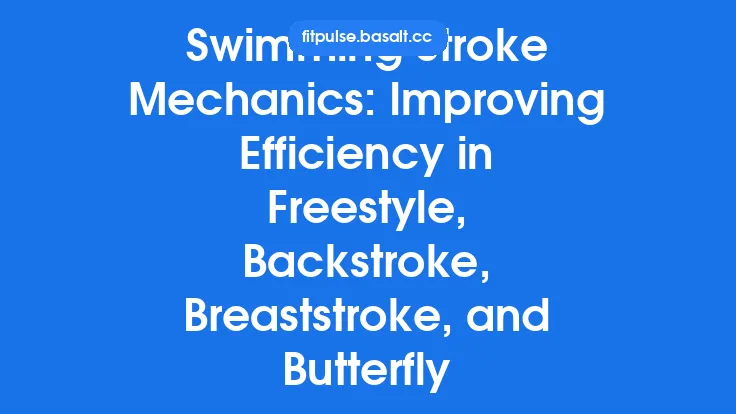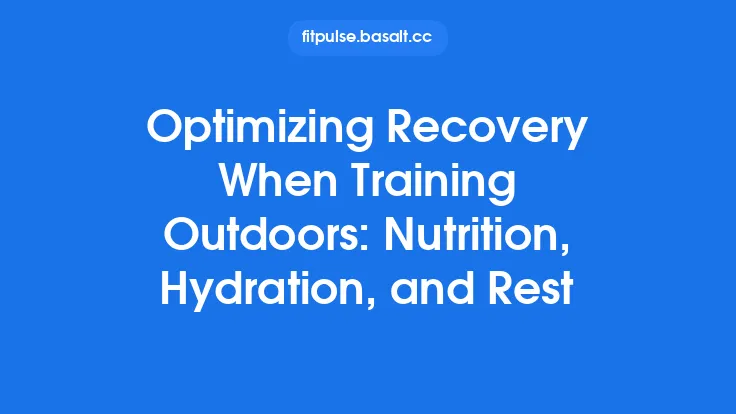Breaststroke is often perceived as the “slow‑and‑steady” stroke, but at the elite level it becomes a finely tuned dance of timing, glide, and efficiency. When each phase of the stroke is synchronized, the swimmer can cover more distance with less energy, maintain a higher average speed, and delay fatigue over longer races. This article breaks down the mechanics that make a breaststroke efficient, explains how to fine‑tune each component, and offers practical drills and feedback methods that swimmers of any level can incorporate into their training.
The Core Elements of Breaststroke Timing
The breaststroke cycle can be divided into four distinct phases: the pull, the breath, the kick, and the glide. The key to speed lies not in the strength of any single phase but in the seamless transition between them.
| Phase | Primary Goal | Typical Duration (as % of cycle) |
|---|---|---|
| Pull | Generate forward thrust by moving the arms outward, then inward along a “keyhole” path. | 20‑30 % |
| Breath | Inhale while the head lifts, keeping the torso aligned to minimize drag. | 5‑10 % |
| Kick | Convert stored elastic energy into a powerful, propulsive thrust. | 20‑30 % |
| Glide | Allow the body to coast, maintaining a streamlined position while the water “fills in” behind the swimmer. | 30‑45 % |
A well‑timed stroke often follows a “pull‑kick‑glide” rhythm: the pull and kick should overlap slightly, but the glide must be long enough to let the momentum generated by the kick carry the swimmer forward before the next pull begins. If the glide is too short, the swimmer wastes energy fighting drag; if it is too long, the swimmer loses speed.
Timing cues that coaches frequently use:
- “Pull, breathe, kick, glide” – a verbal reminder to complete each phase before moving on.
- Metronome beats – setting a beat that matches the desired stroke rate (e.g., 30 beats per minute for a 2‑second cycle).
- Feel‑based cues – “feel the water push back on your hands” during the pull, “snap the kick like a spring” during the kick, and “let the body float” during the glide.
Mastering the Glide: Balancing Speed and Efficiency
The glide is the most misunderstood part of the breaststroke. Many swimmers instinctively rush into the next pull, fearing they will “lose momentum.” In reality, the glide is where the energy from the kick is fully transferred into forward motion.
Key principles for an effective glide:
- Streamlined Body Position – Keep the head in line with the spine, eyes looking slightly forward, and the hips near the surface. A slight “head‑up” posture creates unnecessary frontal drag.
- Horizontal Alignment – The torso should be as flat as possible; a slight “S‑curve” (head down, hips up) can increase drag dramatically.
- Controlled Breathing – Inhale quickly during the brief breath window, then exhale continuously through the nose or mouth while the face returns to the water. This prevents the head from bobbing up and down.
- Optimal Glide Length – Use a “feel‑test”: after a strong kick, glide until you feel a gentle deceleration. That point marks the end of the efficient glide. Over‑gliding (coasting past that point) wastes time; under‑gliding (starting the pull too early) wastes the thrust already generated.
A practical way to train glide length is the “30‑second glide drill.” Swim a normal breaststroke, but after each kick, hold the glide for a count of three seconds before initiating the pull. Gradually reduce the count as you become comfortable with longer glides.
Optimizing the Pull: Hand Path and Propulsion
The hand movement in breaststroke is often described as a “keyhole” shape: hands start extended forward, sweep outward, then sweep inward toward the chest before extending again. The efficiency of this motion depends on three factors: entry angle, sweep width, and recovery speed.
- Entry Angle – Hands should enter the water with palms slightly cupped and fingers together, creating a small “catch” surface that minimizes splash and drag. A too‑wide entry forces the swimmer to fight against the water’s resistance.
- Sweep Width – The outward sweep should be wide enough to engage the pectoral muscles but not so wide that the hands travel a long distance without generating thrust. A good rule of thumb is to keep the hands roughly shoulder‑width apart at the widest point.
- Inward Pull – As the hands move inward, they should follow a slightly “V‑shaped” path, pulling the elbows high and close to the surface. This maximizes the use of the latissimus dorsi and the chest muscles.
- Recovery Speed – Once the hands meet under the chest, they should extend forward quickly, snapping the elbows back to the entry position. A rapid recovery reduces the time spent in a high‑drag position.
Drill: “Sculling Pull.” While maintaining a normal kick, focus solely on the hand movement. Perform a slow scull during the outward sweep, then a quick, powerful inward pull. This isolates the pull mechanics and builds proprioception.
Kick Mechanics: Generating Power without Drag
The breaststroke kick is a unique “whip‑like” motion that stores elastic energy in the hip flexors and quadriceps, then releases it explosively. The kick can be broken down into three sub‑phases: the recovery (or “heel‑to‑butt” phase), the snap, and the glide.
- Recovery – From a fully extended leg, bend the knees and draw the heels toward the buttocks while keeping the knees close together. The ankles should be flexed (toes pointed) to create a “frog‑like” shape.
- Snap – The legs then snap outward and backward in a rapid, circular motion. The power comes from the rapid extension of the hips and knees, not from the sheer force of the legs pushing against the water.
- Glide – As the legs straighten, the feet should finish in a streamlined position, toes pointed, and the legs fully extended. The swimmer should feel the water “pull” the body forward.
Common kick errors and fixes:
| Error | Cause | Correction |
|---|---|---|
| “Kicking too early” (overlap with pull) | Mis‑timed transition, trying to increase stroke rate | Practice the “pull‑kick‑glide” rhythm with a metronome; delay the kick until the pull is fully completed. |
| “Wide kick” (feet splay outward) | Excessive knee separation, lack of ankle flexibility | Perform “wall‑kick” drills holding a kickboard, focusing on keeping knees together. |
| “Insufficient snap” (slow, weak kick) | Weak hip extensors, poor ankle flexibility | Incorporate dry‑land hip‑extension exercises (e.g., glute bridges) and ankle mobility drills. |
Drill: “Vertical Breaststroke Kick.” In deep water, maintain a vertical position with arms crossed over the chest and perform only the kick. This isolates the kick, forces a quick snap, and builds leg power without the interference of arm movements.
Breathing Coordination and Body Position
Breathing in breaststroke is naturally synchronized with the pull, but the timing can still be refined for efficiency. The optimal pattern is:
- Inhale – As the hands finish the inward pull and begin the forward extension, lift the head just enough for a quick, deep breath.
- Exhale – Begin exhaling as soon as the head starts to descend, continuing the exhalation through the glide phase.
A common mistake is “holding the breath” during the glide, which raises the torso and creates drag. To avoid this, practice the “2‑second inhale, 3‑second exhale” rhythm while swimming slowly, focusing on a smooth, continuous exhalation.
Body position is tightly linked to breathing. Keep the core engaged to prevent the hips from sinking. A strong core stabilizes the torso, allowing the head to move minimally while still achieving a full breath.
Drill: “Head‑Up, Head‑Down.” Swim a length of breaststroke, alternating every 5 meters between a deliberate head‑up breath (exaggerated) and a minimal head‑down breath (quick). This contrast helps the swimmer feel the drag difference and reinforces efficient head movement.
Integrating Drills for Timing and Glide
A well‑structured drill set can embed the timing‑glide relationship into muscle memory. Below is a sample 1,200‑meter drill set that targets each component:
| Distance | Drill | Focus |
|---|---|---|
| 4 × 75 m | Pull‑Kick‑Glide (25 m pull only, 25 m kick only, 25 m full stroke) | Isolate each phase, reinforce transition |
| 4 × 50 m | Sculling Pull (hands scull on the outward sweep, normal inward pull) | Hand path, catch efficiency |
| 4 × 50 m | Vertical Kick (no arms) | Snap speed, leg power |
| 2 × 100 m | 30‑Second Glide (count to three after each kick) | Glide length awareness |
| 2 × 100 m | Full Stroke with Metronome (set at target stroke rate) | Consistent timing, rhythm |
Rest intervals of 15–20 seconds between 50‑meter repeats and 30 seconds between 75‑meter repeats allow the swimmer to focus on technique rather than fatigue.
Video Analysis and Feedback Loops
Even the most experienced swimmers benefit from objective visual feedback. Modern smartphones and waterproof action cameras make video analysis accessible. Follow these steps for an effective feedback loop:
- Record from Multiple Angles – Side view (to see body alignment and glide), underwater view (to see hand and foot paths), and overhead view (to assess symmetry).
- Identify Key Frames – Capture the moment of hand entry, peak of the kick, and start of the glide.
- Compare to a Model – Use a reference video of an elite breaststroker or a biomechanical model to spot deviations.
- Set Specific Goals – Instead of “improve glide,” set “extend glide by 0.5 seconds before initiating the next pull.”
- Re‑record After 2–3 weeks – Measure progress quantitatively (e.g., stroke rate, distance per stroke) and adjust the training focus accordingly.
A simple “tech‑check” after each practice (5 minutes of video review) keeps the swimmer’s mind attuned to the technical cues and prevents bad habits from solidifying.
Race‑Day Strategies for Sustained Efficiency
During a race, the swimmer must balance the desire for speed with the need to preserve technique under fatigue. The following strategies help maintain efficiency from start to finish:
- Start and Pullout – Execute a powerful dolphin kick followed by a streamlined glide, then transition into the first full breaststroke cycle with a slightly longer glide than in training to capitalize on the initial momentum.
- Mid‑Race Rhythm – Adopt a slightly higher stroke rate than in practice, but keep the glide proportionally longer to avoid “choking” the stroke. A common approach is a “2‑2‑2” pattern: two strong pulls, two quick kicks, two glides, repeated.
- Final 25 m Sprint – Shorten the glide gradually while increasing kick intensity. The swimmer should still maintain a streamlined body; a rushed, high‑drag posture will negate the speed gain.
- Mental Cue – Use a simple mantra such as “pull, snap, glide” to keep the technique front‑of‑mind even when breathing becomes labored.
Common Technical Pitfalls and How to Fix Them
| Pitfall | Symptom | Fix |
|---|---|---|
| Excessive Knee Spread | “Wobbling” legs, loss of propulsion | Perform “wall‑kick” drills, focus on keeping knees together during recovery. |
| Hands Too Wide on Entry | Increased splash, slower pull | Practice “narrow entry” drills with a pull buoy, keep palms just outside the shoulder line. |
| Glide Too Short | Rapid fatigue, high stroke count | Use the 30‑second glide drill to develop feel for optimal glide length. |
| Head Bobs Too High | Increased frontal drag, disrupted body line | Strengthen core, practice “head‑down, eyes forward” breathing. |
| Late Kick | Overlap with pull, reduced thrust | Count beats: pull (2), breathe (1), kick (2), glide (3). Use a metronome to internalize timing. |
Addressing these issues early prevents the formation of ingrained habits that are harder to correct later.
Putting It All Together: A Progressive Practice Plan
Weeks 1‑2 – Foundation
- Focus: Isolate each phase.
- Sessions: 3 × week, 1,500 m total. Include vertical kick, sculling pull, and glide‑count drills.
Weeks 3‑4 – Integration
- Focus: Combine phases with emphasis on timing.
- Sessions: 4 × week, 1,800 m total. Introduce metronome‑guided full strokes, 30‑second glide sets.
Weeks 5‑6 – Race Simulation
- Focus: Apply technique under fatigue.
- Sessions: 5 × week, 2,200 m total. Include sets with descending rest intervals, sprint finishes, and video analysis.
Weeks 7‑8 – Refinement
- Focus: Fine‑tune minor errors identified in video review.
- Sessions: 4 × week, 2,000 m total. Emphasize targeted drills (e.g., wall‑kick for knee control, narrow‑entry pull).
Throughout the eight‑week cycle, maintain a logbook noting stroke rate, distance per stroke, perceived glide length, and any technical cues used. Review the log weekly to ensure the swimmer is progressing toward longer glides, smoother transitions, and a lower overall stroke count for a given distance.
By mastering the interplay of timing, glide, and efficiency, a breaststroker can transform a seemingly “slow” stroke into a powerful, economical engine of speed. The principles outlined above are timeless—applicable whether you are training for a local meet, a national championship, or simply seeking to swim more smoothly for health and enjoyment. Consistent practice, focused feedback, and a keen awareness of each phase will keep your breaststroke moving forward with grace and speed.





